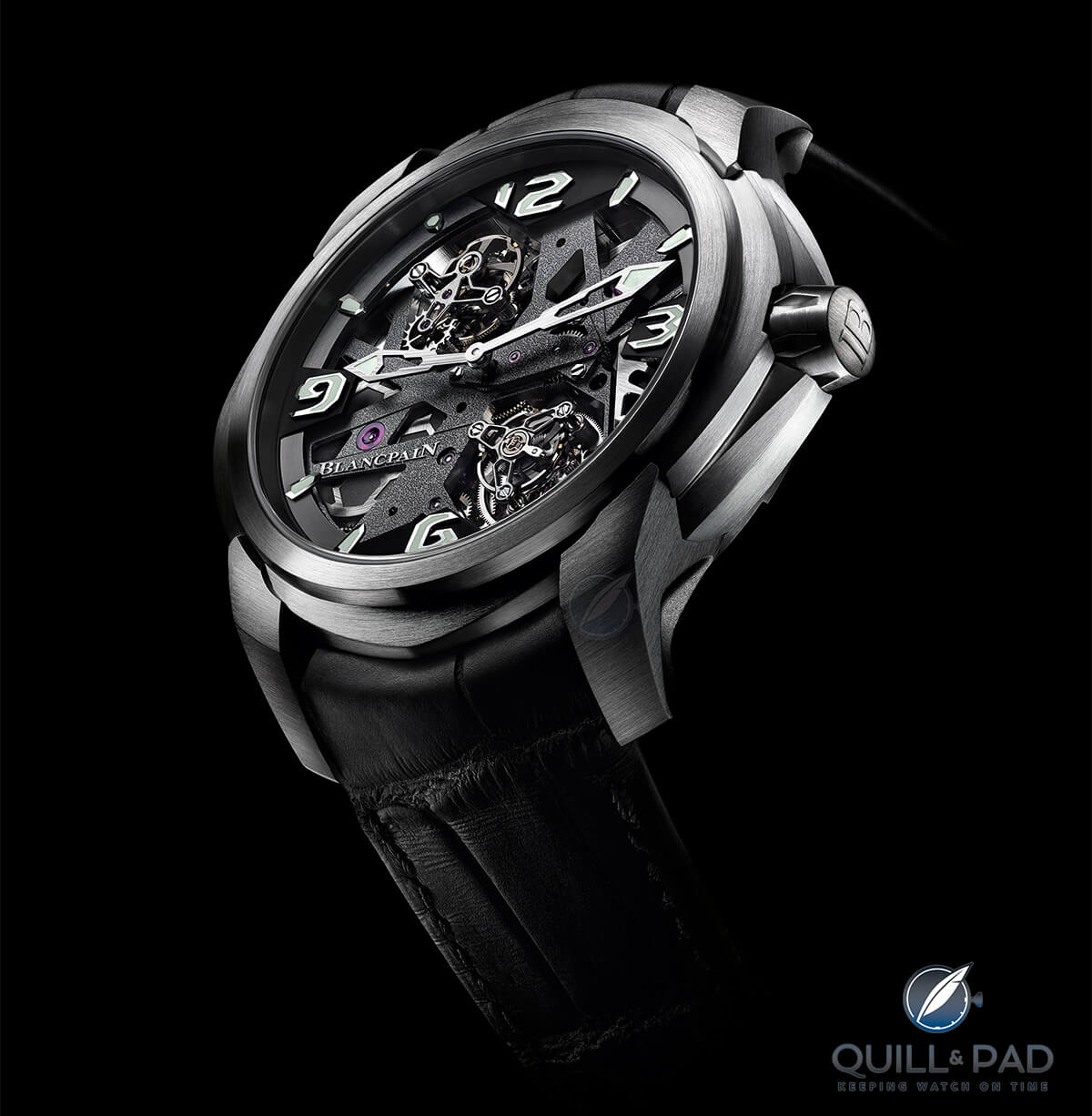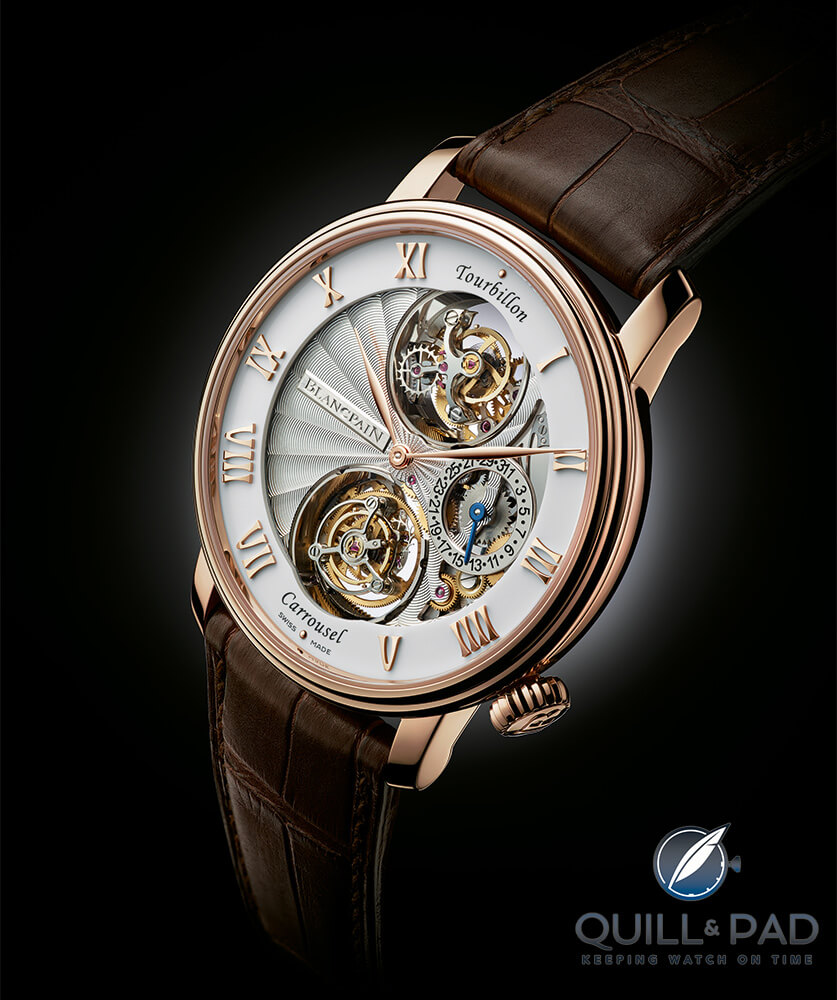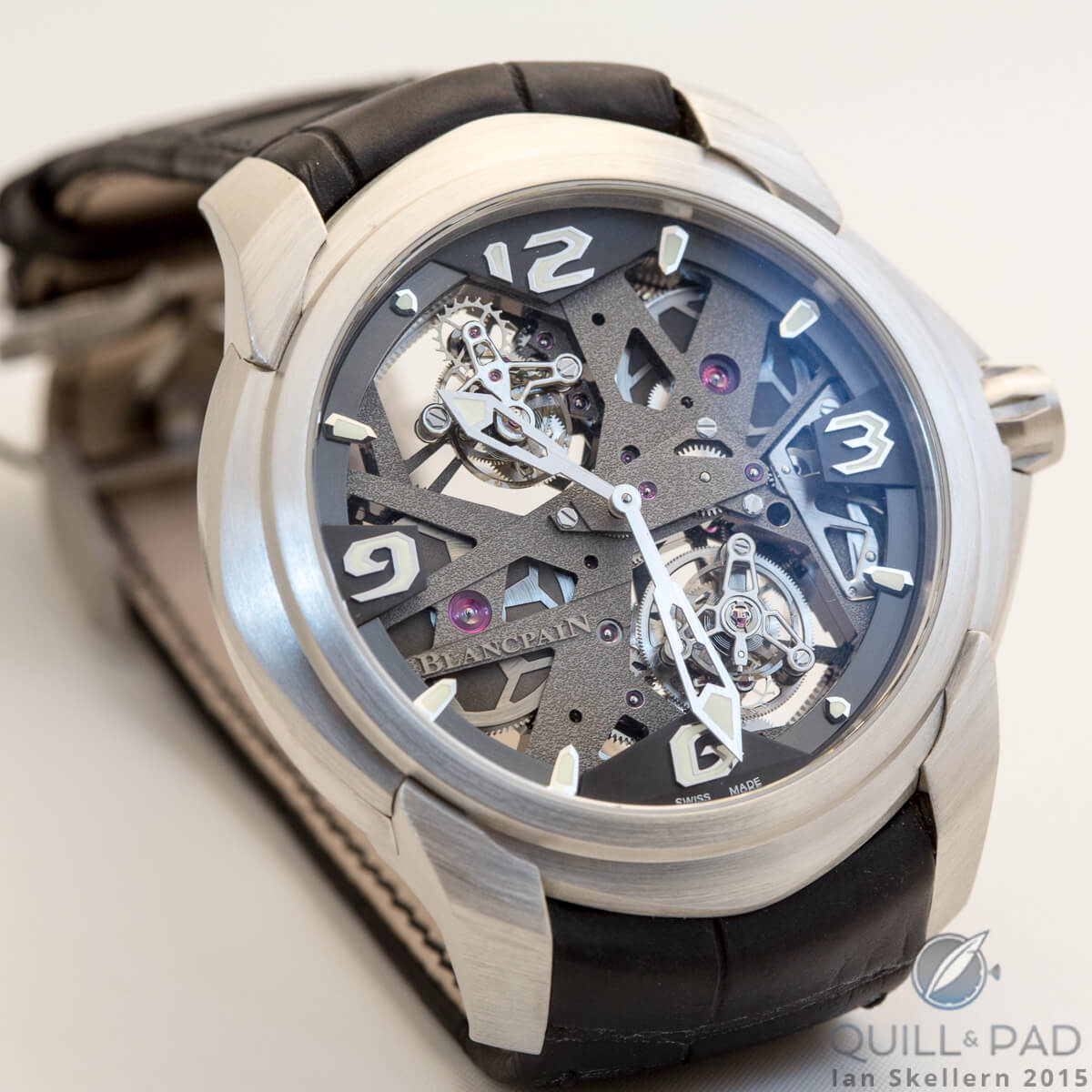Way back in 1892, Bahne Bonniksen, a Danish watchmaker living in England, patented his new invention. He called his arrangement of rotating wheels and gears the karussel thanks to its motions. “Karussel” means “carrousel” in his native Danish.
In 1801, almost a century before, Abraham-Louis Breguet patented a device he called the tourbillon (French for “whirlwind”).
Neither Breguet nor Bonniksen had invented a special escapement – both basically enveloped existing escapements in a revolving cage or carriage. The goal of both was to improve precision in the mechanical (pocket) watch movement by averaging out the effects of gravity on the escapement.

Wheels, wheels, wheels: a view through the display back of the Blancpain L-evolution Tourbillon Carrousel
The most significant difference between the tourbillon and the karussel is that Bonniksen’s device is driven by the third wheel (the transmission wheel between the wheels driving the minutes and seconds) instead of the fourth wheel (which also drives the second hand).
This fact makes the karussel much sturdier and less prone to shock than the traditional tourbillon. In his reference work Watchmaking, iconic independent watchmaker George Daniels states that Bonniksen’s invention, while able to average all the poise errors of the balance into a uniform daily rate just as well as the tourbillon, was “simpler to construct and could be produced in quantity at a relatively low price.”
However, it never was produced in quantity, at least not in wristwatch form.
Daniels also stated his view on a comparison in the same book, “. . . the tourbillon is altogether more pleasing in appearance.” This probably explains why there have been next to no wristwatch karussels before Blancpain embarked upon the journey to make a wristwatch version of a karussel that is pleasing to the eye.
Karussel / carrousel merry-go-round
Since the introduction of Blancpain’s first tourbillon wristwatch, there’s been bit of confusion in high-end mechanical horology about the karussel. And here’s why.
In 1989, Blancpain released its first tourbillon. This ultra-thin tourbillon movement, designed by independent watchmaker Vincent Calabrese, was described as a traditional flying tourbillon by the brand. However, it did contain a slight modification over the standard one-minute Breguet tourbillon in that it was mounted excentrically: one of the wheels in Calabrese’s design is off-center, therefore making its wheel arrangement co-axial.
His main reason for doing this was to reduce the height of the tourbillon mechanism, which made for a thinner movement and therefore a thinner and more elegant wristwatch.
Oddly, this style of tourbillon came to be called the “carrousel” by French speakers and even the Swiss watchmaking school WOSTEP. However, the word simply refers to this variation on the “conventional” tourbillon. The striking similarity to Bonniksen’s word, however, has caused a general degree of confusion among aficionados and enthusiasts.
Carrousel Volant Une Minute
This “confusion” increased to an even greater degree in 2008 when Blancpain introduced another innovation designed by Calabrese: a new version of Bonniksen’s karussel in a wristwatch called the Carrousel Volant Une Minute.
Bonniksen himself did not work with one-minute variations of his invention, but rather with three different rotational speeds: 52 ½ minutes (described in the original patent), 34 minutes, and 39 minutes.
When Calabrese began developing this particular masterpiece, however, he thought that anything slower than one minute would be boring for the wearer. So he added two extra wheels to the karussel train so that it rotated in just sixty seconds. The wristwatch that emerged could well be considered the world’s first wristwatch karussel.
As well as the world’s fastest!
Carrousel and tourbillon in one
In 2013, Blancpain did something else extraordinary by once again calling upon Calabrese’s skills. This time in developing a wristwatch called the Le Brassus Tourbillon Carrousel, which combined the two revolving escapements – tourbillon and karussel – into one movement.
With its spectacularly visible flying tourbillon at 12 o’clock and the visible flying carrousel at 6 o’clock, it goes without saying that manually wound Caliber 2322 was the first of its kind.
Each escapement boasts its own spring barrel (the crown winds both simultaneously and guarantees equal winding). Linked by two differential gear systems, one of the spring barrels transmits the average rate of both regulators to the indications while the other drives the power reserve indication on the back of the watch.

The hard, angular movement plates and bridges of the Blancpain L-evolution Tourbillon Carrousel give the watch a very contemporary look and feel
The tourbillon carriage is linked to its spring barrel via a single gear train, which in essence means that if the mechanical connection is interrupted, the tourbillon also stops rotating. The carrousel, on the other hand, is connected to the barrel by two gear trains. The first one delivers the energy required for the escapement to function, while the second controls the carriage rotation speed. This carrousel is much more complicated than the original that inspired it.
Though the two regulators differ in their designs and technical set-ups, their goal is one and the same: increased precision.
In 2013, the Le Brassus Tourbillon Carrousel featured a traditionally styled grand feu enamel dial and classic red gold Roman numerals, the latter complementing the 44.6 mm red gold case.

Blancpain L-evolution Tourbillon Carrousel: the modern 2015 variation on the complicated whirlwind theme
Part deux: a sportier carrousel and tourbillon in one
It is no secret that since Marc Hayek has taken over the direction of Blancpain, he has injected a more contemporary feel for luxury into the brand, adding a sportier outlook to its rich traditional values. This has materialized in part due to Hayek’s love of motorsports, which itself has culminated in bringing about a partnership with Italian luxury carmaker Lamborghini and the new sports line called L-evolution.
At Baselworld 2015, Blancpain thus introduced the latest evolution of the classy, complicated Tourbillon Carrousel in the casual L-evolution line. While its adventurous look may be subject to personal taste – and has indeed induced some discussion in the watch world – the incredible ingenuity behind its complicated movement still leaves one simply awestruck.

A close look at the dial side of the Blancpain L-evolution Tourbillon Carrousel: the tourbillon regulator is at the top of this image and the carrousel at the bottom
This latest version’s more aggressive design intentions begin with the stately 47.4 mm platinum case and its distinctive bezel, both of which immediately catch the eye. This makes a strong statement as high complications are generally housed in very classically designed cases so that they run less risk of going out of style.
The visible plates and bridges, which were first traditionally frosted and then galvanically coated in high-tech manner with NAC, are partially openworked to reveal the airy, skeletonized movement below. There is no dial, and thus the ruby red of the 70 (count ҆em!) bearing jewels adds the only splashes of color. The visible movement screws now have hexagonal shapes, a first for Blancpain, further adding to the contemporary design.
Both the tourbillon and carrousel cages have been subtly reshaped to match this ultra-modern, sporty look.
The Blancpain L-evolution Tourbillon Carrousel intersects the past and the future of horology in a meaningful and imposing way.
For more information, please visit www.blancpain.com/en/news/blancpain-reunites-once-again-tourbillon-carrousel-new-form.
Quick Facts L-evolution Tourbillon Carrousel
Movement: manually wound Caliber 2322V2 with one-minute flying tourbillon and one-minute flying carrousel with differential; frosted plates and bridges galvanically coated with NAC; 70-hour power reserve
Case: 47.4 x 11.66 mm, platinum
Functions: hours, minutes; power reserve indication on back
Limitation: 50 pieces
Price: $373,130




























































Trackbacks & Pingbacks
[…] Learn more about this rare mechanical specialty’s evolution in L-Evolution Tourbillon Carrousel By Blancpain: Whirlwind And Karussel Converge. […]
Leave a Reply
Want to join the discussion?Feel free to contribute!